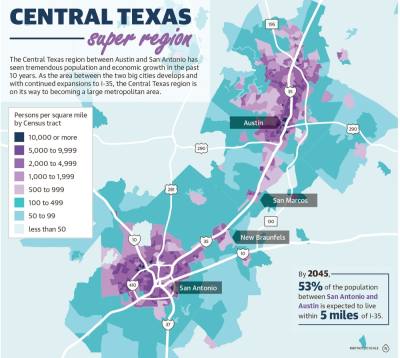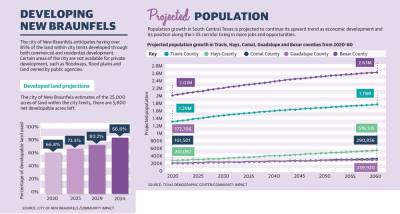By 2045, 53% of the population between San Antonio and Austin is expected to live within 5 miles of I-35, according to a 2019 study by the Capital Area Metropolitan Planning Organization and the Alamo Area Metropolitan Planning Organization.
In this study, the two organizations analyzed growth in the counties between San Antonio and Austin.
By 2060, Bexar County is projected to reach a population of more than 2.6 million, and Travis County is expected to reach more than 1.7 million, according to data from the Texas Demographic Center.
Jordan Matney, New Braunfels assistant city manager, said the position of the cities on the I-35 corridor has influenced its economic growth and development.“I think when I-35 traverses your city, you’re sort of primed for growth,” Matney said. “I think the entire state of Texas is seeing a large amount of growth within the last 10 to 20 years. And a lot of those cities on the I-35 corridor ... have seen some rapid development.”
From 2022-60, Hays County is expected to have a 105% increase in population, while Comal County will increase by 74%, and Guadalupe County will increase by 47%, according to data from the TDC.
Alongside population increases, traffic will increase throughout the corridor, and businesses will continue to move in, leaving organizations such as AAMPO and CAMPO to plan ahead and prioritize future road projects.
Connecting the corridor
Laura Lopez, the San Antonio district public information officer for the Texas Department of Transportation, said the organization is working to address future traffic growth and congestion on I-35.
Each day, 100,000-150,000 vehicles use the section of I-35 between San Antonio and Austin. Many of these vehicles are carrying people commuting between the two cities on a daily basis, Lopez said.
TxDOT projects include the I-35 Northeast Expansion, which is a three-part project that will add elevated lanes and additional lanes on the highway.
The central portion of the project broke ground in May and will add 9.5 miles of elevated nontolled lanes from I-410 North to FM 3009, Lopez said.
This $1.5 billion project is part of the Texas Clear Lanes initiative, which focuses on addressing congestion throughout the state. The project is expected to be completed in 2027.
In 2024, TxDOT will begin work on I-35 NEX South, which runs from North Walters Street to Loop 410 North.
The final portion of the three-part project will be I-35 NEX North, which will focus on the area of I-35 between FM 3009 and FM 1103. This project is unfunded, according to Lopez.
Lopez said even with the increase in vehicles traveling on I-35 NEX, future travel times are expected to improve by 41% to 48% on I-35 from FM 3009 to the AT&T Center, which is 15.5 miles.
“Without the I-35 NEX project, travel time is about 29 minutes on the main lanes of I-35,” she said. “With the I-35 NEX project, travel time will be 17 minutes on the main lanes and 15 minutes on the elevated lanes.”
Traversing the future
In 1984, the Greater Austin-San Antonio Corridor Council was created to support long-term infrastructure and economic development for the Austin-San Antonio corridor.
The organization is a regional nonprofit public-private partnership composed of more than 130 political jurisdictions, public authorities and businesses. Corridor Council President Ross Milloy said $10 billion will be put into I-35 growth over the next five to 10 years from planned projects alone.
In 2016, the Lone Star Rail District, which was to be a commuter rail between Austin and San Antonio, died after a vote from CAMPO.
Despite the end of this project, Milloy believes the idea of rail is likely to return.
“I still think that a rail connection between Austin and San Antonio is necessary and inevitable,” he said. “It is unfortunate what happened with Lone Star Rail, but that is in the past, and there are some new programs from the feds that I think are exploring this.”
Milloy said programs from organizations such as Amtrak could be helpful in a new project or initiative in the future.
Another organization, San Antonio-based VIA Metropolitan Transit, is working to start a pilot program that will provide public bus routes between the two cities with stops in San Marcos and New Braunfels.
Other concerns for the corridor, especially within Austin and San Antonio, are water and air quality, according to Milloy.
“Air quality continues to be a concern,” he said. “San Antonio, I think, is probably moving into nonattainment, and Austin is probably not far away.”
Should the two cities move into nonattainment—or “smog city” classification due to ground-level ozone measurements—it would lead to restrictions on development and could lead to inspection fees across Bexar County, according to Milloy.
To help fight pollution, the Electric Transportation Compact was created in 2020.
This organization is tasked with responding to the leading cause of air pollution in the South Central Texas region.
Bexar and Travis counties work with this organization to upgrade their fleets to electric vehicles.
Even while pushing for electric vehicles and a new rail system to address future growth and development needs, there is still a congestion issue, leaving I-35 to need extra capacity sooner, Milloy said.
“I think we are going to have to rely on trying to beef up high-capacity transit between Austin and San Antonio,” he said.
Economic growth
San Antonio Mayor Ron Nirenberg said the corridor growing into a metroplex is an inevitability.
“My hope is that in the process, the two cities become better versions of themselves and specifically San Antonio continues to grow into a more inclusively prosperous place that retains its unique cultural heritage,” Nirenberg said.
Nirenberg said he would also like the city to look toward connectivity between the east and west sides.
“With progress on the north-south line well underway, it’s time to look even further into the future and plot a course for a corridor connecting East and West San Antonio—and elevate the potential of historically underserved areas,” he said.
As Austin and San Antonio continue to thrive and prosper, the cities in between must race to keep up with demand.
Jonathan Packer, president and CEO of the Greater New Braunfels Chamber of Commerce, said he thinks the Austin-San Antonio region has a lot of the characteristics that make up a strong metroplex, such as two international airports, highway connection and economic development in unique business sectors.
“I think one other hallmark that’s really important where we have more work to do is just on the general collaboration between the two cities and the other cities in the region,” Packer said. “So I think that’s an area that—as we look to the future—cities learning to work together more intentionally and collaboratively as a region is the next wave that I look forward to seeing.”
Traversed by and adjacent to the I-35 corridor are Hays and Caldwell counties, which are overseen by the Greater San Marcos Partnership.
“All the communities within those two counties are all partners in the [GSMP], so our intent is to bring the jobs, and for the last three years ... we have basically been breaking every record the organization’s ever set in terms of hitting that mission,” GSMP President and CEO Jason Giulietti said.
The GSMP has brought in more than $2 billion of new investments to its communities, which directly translates to thousands of jobs, Giulietti said.
A thriving New Braunfels
With the tremendous growth in the county, the city of New Braunfels has seen significant economic and residential development as well as transportation and infrastructure improvements.
Comal County was named the second fastest-growing county in the nation in the 2020 census with a 48.9% increase in population from 2010. The population of Comal County is projected to reach over 290,000 by 2060, and Guadalupe County will climb to nearly 260,000 in the same time frame, according to the TDC.
Packer said New Braunfels has seen a shift in its demographics that allows the city to achieve things not attainable in the past.
“What we’ve seen is that our population growth has been tremendously concentrated with a highly educated workforce in their prime working years with children in schools,” Packer said.
Matney said the city of New Braunfels has helped influence the growth of the area by making sure developers have transportation plans and major thoroughfares, walkability and amenities that meet the needs of the community.
According to the city, about 87% of the 25,000 acres in the city limits are projected to be developed by 2034.
“From a trend perspective, that should inform a lot about what we could expect to see,” Packer said. “We should expect to see a higher percentage of projects that are redevelopment projects, as opposed to projects that stretch your city boundaries.”










